Veery
The more we learn, the more wonderful and mysterious this thrush with the ethereal song proves to be.
(Listen to the radio version here.)
On June 24, I took a lovely morning walk at Waabizheshikana. While I was still in the parking lot I heard a Veery—one of the splendid birds who are much more often heard than seen. By the end of my walk, I’d heard at least 15 different individuals, and a few gave me photo ops.
A few days earlier, I recorded one with my iPhone, though not as close as I wished. I got a better recording, though of just a single song, when making a video with my good camera on June 13, 2021.
The Veery was the first thrush I ever saw other than a robin, when I finally found one singing away in the Red Cedar Woodlot at Michigan State University on May 13, 1975. (It became #37 on my life list.) I’d been hearing Veeries in a few places for several days before that without a clue what they could be, but I didn’t have any bird recordings of my own and didn’t know which species to listen to on the University library’s recordings. My only hope of figuring out who was singing the ethereal song was to track down the bird singing it.
I didn’t realize it at the time, but searching like that for every bird singing an unfamiliar song stamped those songs permanently into my brain. It took longer for me to commit to memory songs pointed out on field trips, unless I later found the bird on my own. I suspect the same would be true if I tried to learn bird songs using Cornell’s Merlin app. Like my bird recordings and field guides, Merlin is a great tool, and very fun to use, but for me there is still nothing like searching for the source of a bird song for minutes, or hours, or days, and finally watching as that song comes out of a particular singer’s mouth to sear the song into a lasting memory.
Over the years, countless people have called and emailed me asking me to identify bird songs. Verbal descriptions of bird sounds are wildly variable, and I often have no idea what bird they’re asking about, but the first clue that it might be a Veery is if they say they heard the song in the evening—Veeries tend to sing most around sunrise and at dusk. Whatever time of day they heard it, the clear giveaway is if they describe the song using the word “spiraling.” That extraordinary quality is what makes Veery songs so memorable.
Veeries sing way up in the treetops, at mid-story, and even eye-level, but are usually hidden in the foliage. They feed in trees, too, but often drop to the ground to pick up insects, sometimes on paths that run through the moist forests and woodlots where they spend spring and early summer.
My grandson Walter got a glimpse of one on the trail at Waabizheshikana a couple of weeks before I took my solo walk, though it was silhouetted and flew off before we got close enough for me to point out the bird’s soft, rusty upperparts and snow-white underparts with very subtle spotting on the breast.
Walter wasn’t disappointed that it flew away—he was having too much fun stomping in every puddle. Long ago he figured out that Dee Dee Nana is mostly interested in birds the way he’s mostly interested on cars, construction vehicles, and puddles. He’s cooperative and indulgent when I’m looking for birds knowing that I’ll be cooperative and indulgent when we come upon something he wants to see. Everyone has different interests, but Walter is learning that family and friends take pleasure in everyone else’s enjoyment, too.
Veeries are extremely easy to hear in moist forests of southern Canada and adjacent northern states down into the Appalachians, at least into early July. They breed in some of the same woodlands as Hermit and Wood Thrushes, but the Veery’s preference is younger, wetter woods—I associate them with ferns.

Veeries eat fruit and insects, with the bigger focus on insects up here on their breeding grounds, and more on fruits on their South American wintering grounds. They’re on their breeding grounds for barely three months of the year, arriving in May, virtually done with eggs by the end of June, their fledglings pretty much on their own by mid-July. The adults molt their feathers in late July and August, even as they’re heading out for central South America, which they’ve reached by the end of September. Every Veery hatched up here will spend the bulk of its life in South America. Fortunately for us, up here is the right place for Veeries to raise children, so they faithfully return year after year.

Recent research using high-tech geolocators and miniature GPS devices put on Veeries captured in Delaware and British Columbia, 4,000 miles apart, gave scientists some head-spinning insights into Veery movements in winter. The tracked birds first migrated to a region south of the Amazon, mostly in south-central Brazil on the Brazilian Shield geologic formation. But in mid-February, they moved north, west, or southwest of the Brazilian Shield to a second, more widespread area, mostly in northern Brazil and southern Venezuela, but also in Guyana, Suriname, and Bolivia. We know that some Veeries winter in southeastern Brazil, but none of the birds with geolocators went there during that study. Where do those birds breed?
This kind of scientific research affirms that the more we learn about just about anything, the more questions we come up with, and the more amazing the natural world proves to be. But all you have to do is listen to the haunting song of the Veery to know that this is a bird who leads a life worth understanding and protecting.





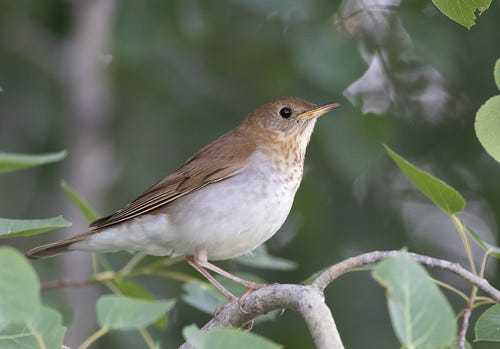
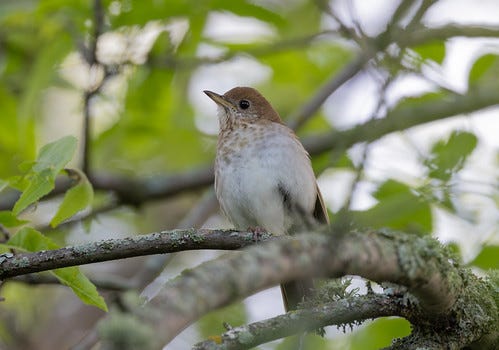
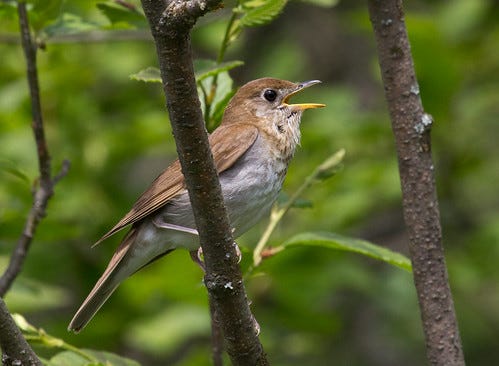
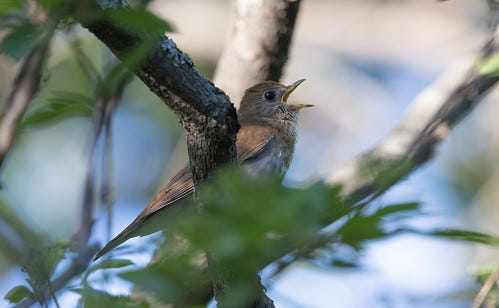
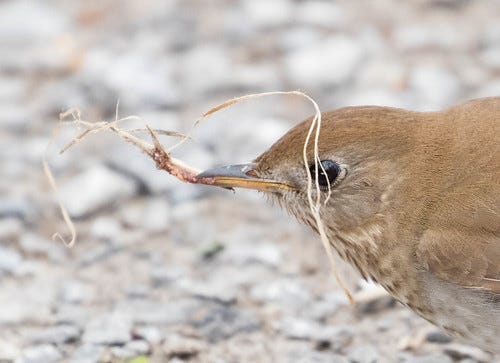

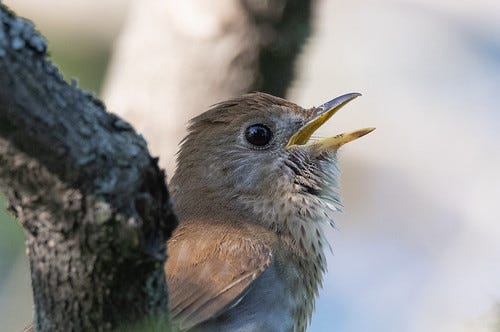
We get Veeries not only in the Pennsylvanian Appalachians but in the New York, New Jersey, and Pennsylvanian Highlands to the southeast in good numbers in good habitat, which unfortunately is too far and in-between, being extremely fragmented. (Wasn't there recent research showing them to be in three new subspecies in our area? I'm not sure, but something has to keep the systematicists busy.) These are upland, moist woodland with shrub understory birds here as well, a disappearing habitat here marking the disappearing of local Wood Thrush, Kentucky Warblers, and Hooded Warblers. The Scarlet Tanagers, too, though they seem to prefer less of an understory here by my eye.
Your blog, like this edition and the bird and its song, is Veery, Veery sweet, beautiful, and soothing.
The Veery was the bird of the day, or rather evening, when we visited Crex Meadows Wildlife Area (Grantsburg, Wisconsin) on July 25th. Sadly, with my hearing loss, I couldn't hear much of their song, but my partner did. I was thrilled to actually see one on a log under much vegetation--such beautiful colors, and such a cute little bird! And then, as we were driving out at dusk, or actually early darkness, we were puzzled by this nondescript looking, roundish little bird with a great big dark eye that was feeding on the edge of the road. Only later did we realize tha tit was a Veery!